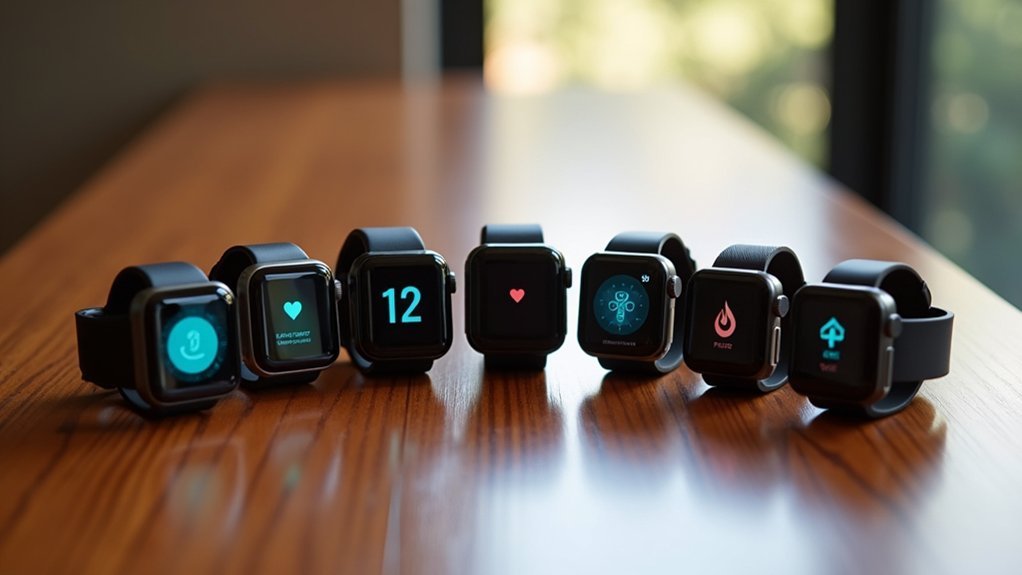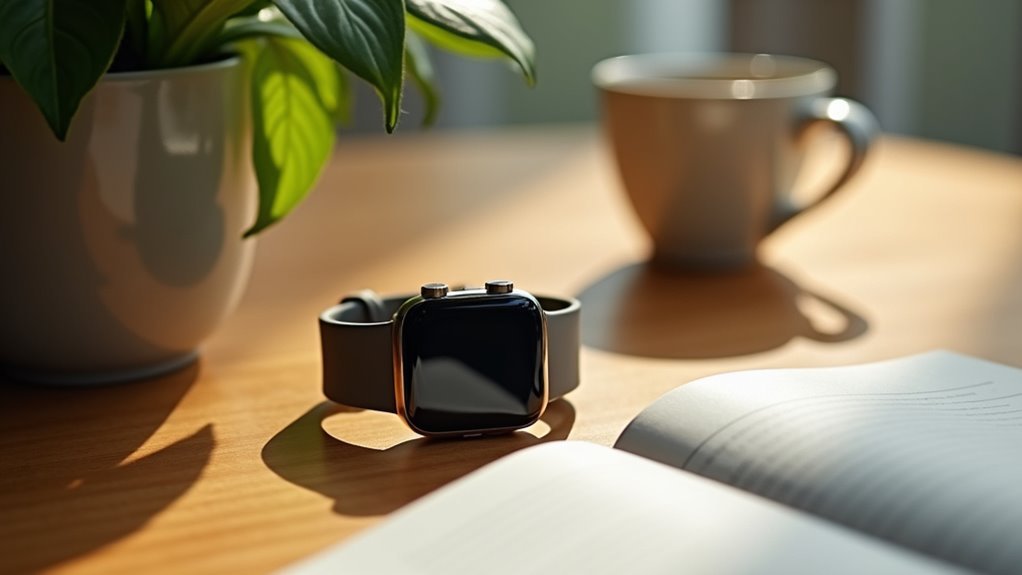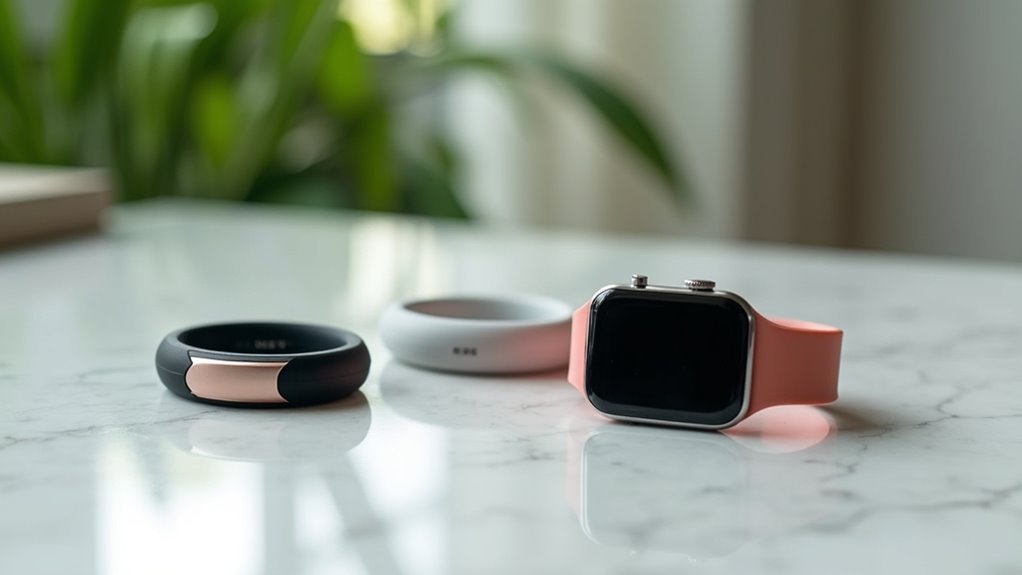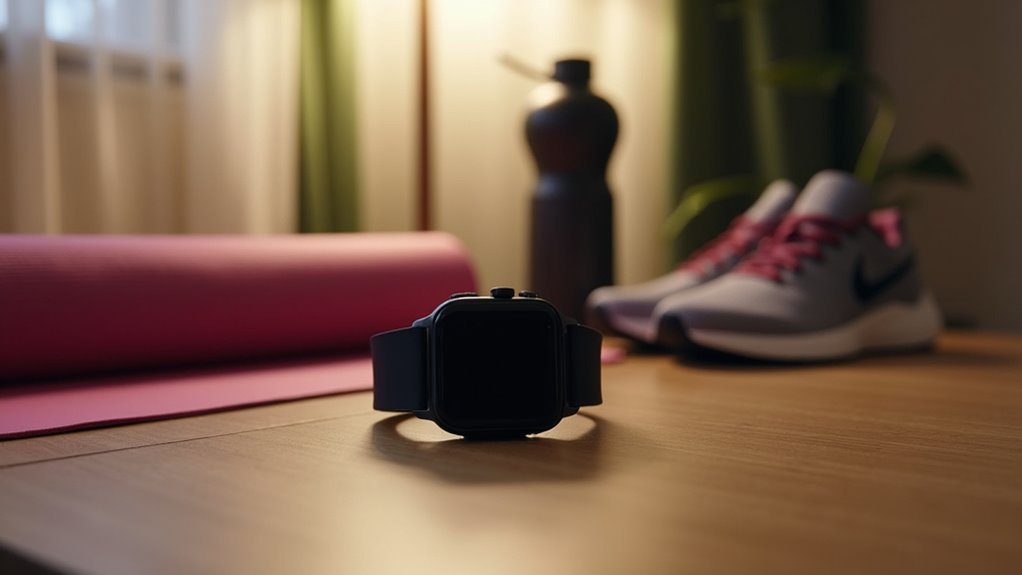For accurate heart rate monitoring, consider the Apple Watch Series (99.9% accuracy), Samsung Galaxy Watch (within 5 bpm of medical devices), WHOOP Strap (99.7% ECG-comparable), Fitbit Sense (solid daily tracking), Garmin Forerunner (elite endurance monitoring), Polar Vantage (±1 bpm precision), or TomTom Runner Cardio (high-intensity reliability). You’ll get the most accurate readings with proper fit and updated firmware. Discover below how each device’s technology delivers clinical-level precision for your specific needs.
Apple Watch Series: The Gold Standard in Heart Rate Precision
Precision in heart rate monitoring distinguishes the Apple Watch Series as the industry benchmark. With near 99.9% accuracy compared to clinical pulse oximeters, you’re getting hospital-grade measurements on your wrist.
The latest models achieve readings within 5 bpm of true values 98% of the time during sedentary activities.
What sets Apple Watch apart is its intelligent approach to measurement. Rather than providing constant but questionable data, it withholds readings when conditions aren’t ideal. However, users report experiencing inconsistent heart rates during specific activities like running, contradicting their physical symptoms.
Series 6 and later models employ a sophisticated machine learning algorithm trained on over 50,000 hours of real-world data from diverse users.
Whether you’re taking a casual stroll or monitoring a heart condition, the Apple Watch excels, showing minimal bias at walking speeds and impressive accuracy even for users with atrial fibrillation.
Samsung Galaxy Watch: Clinical-Grade Monitoring for Active Users
While Apple may dominate headlines, Samsung’s Galaxy Watch delivers impressive clinical-grade heart monitoring that rivals medical devices in controlled settings.
The Galaxy Watch utilizes PPG technology to track your heart rate within 5 bpm of medical-grade monitors during baseline readings. For optimal accuracy, wear the watch snugly above wrist as recommended by Samsung’s positioning guidelines. You’ll notice accuracy diminishes slightly during intense workouts, where movement can interfere with readings.
- Feel confident knowing your Galaxy Watch detects rapid heartbeats with clinical-level precision
- Stay informed about your cardiovascular health with continuous monitoring
- Exercise smarter with real-time feedback, despite some activity limitations
- Trust the data from a device validated in professional medical settings
- Take control of your health with proper positioning for maximum accuracy
WHOOP Strap: Unparalleled HRV Accuracy for Serious Athletes
You’ll find WHOOP’s heart rate tracking achieves remarkable 99.7% accuracy against gold-standard ECG measurements, with the lowest variability among competitors at just 1 bpm standard deviation.
Its specialized HRV measurement during deep sleep phases provides consistency that random daytime measurements can’t match, making it particularly valuable for serious athletes tracking recovery.
This precision has made WHOOP the preferred choice for clinical applications and professional training environments where reliable physiological metrics directly impact performance outcomes. The device calculates HRV using RMSSD methodology, providing sophisticated insights into autonomic nervous system balance.
Elite Recovery Tracking
When it comes to elite recovery tracking, the WHOOP Strap stands in a league of its own with its extraordinary Heart Rate Variability (HRV) precision.
You’ll benefit from its sophisticated algorithm that measures HRV during deep sleep, when your body provides the most consistent readings.
With 99% accuracy compared to medical-grade ECG equipment and a tiny 3.9ms error margin, your recovery data is trustworthy enough for professional training decisions.
The Australian Institute of Sport’s validation study confirms what elite athletes already know—WHOOP delivers clinical-quality metrics in a wearable format. This peer-reviewed research published in Sensors journal demonstrates WHOOP’s superior performance against five other leading wearables.
- Feel confident making critical training decisions based on gold-standard measurement accuracy
- Trust your recovery scores during championship preparation
- Eliminate guesswork about whether you’re truly recovered
- Experience the peace of mind that comes with scientifically validated data
- Join the elite athletes who rely on precision recovery metrics daily
Clinically Verified Precision
The WHOOP Strap’s clinically verified precision sets a new standard in wearable technology, delivering an extraordinary 99.7% accuracy in heart rate measurements compared to medical-grade ECG equipment. You’ll benefit from its remarkable 99% accuracy in heart rate variability monitoring, greatly outperforming competitive devices. However, WHOOP has demonstrated low sensitivity for accurately detecting wakefulness during sleep periods.
| Metric | WHOOP Accuracy | Clinical Application |
|---|---|---|
| Heart Rate | 99.7% | Training optimization |
| HRV | 99% | Recovery assessment |
| Consistency | Dynamic sleep averaging | Long-term trending |
Independent research published in Sensors journal confirms these findings, demonstrating smaller measurement errors compared to other wearables. WHOOP’s calculation method focuses on the last slow wave sleep stage, providing you with consistent baseline measurements that have been deemed acceptable for clinical studies and large-scale physiological research.
Fitbit Sense: Balancing Everyday Tracking With Medical-Grade Features
You’ll find the Fitbit Sense offers extensive health tracking features including ECG capabilities and stress management tools based on heart rate variability.
Its PurePulse technology performs adequately during daily activities and rest periods, but struggles with accuracy during high-intensity workouts, often underestimating peak heart rates by up to 40 BPM.
User experiences vary significantly, with some reporting satisfaction while others note significant inconsistencies when comparing the optical sensor readings against chest strap monitors.
Despite these limitations during vigorous exercise, the Sense provides valuable longitudinal health insights through its continuous monitoring and trend analysis.
Advanced Health Monitoring Capabilities
Fitbit Sense elevates heart rate tracking beyond basic fitness metrics with five integrated health monitoring systems that work in harmony.
You’ll experience continuous PurePulse 2.0 tracking every five seconds, providing insights that connect to your sleep patterns, stress levels, and overall wellness. The ECG app allows you to check for atrial fibrillation on demand, while the skin temperature sensor detects subtle variations that might indicate illness. Real-time notifications alert you when your heart rate reaches high/low thresholds for proactive health management.
- Peace of mind through irregular heart rhythm notifications that watch over you while you sleep
- Empowerment from sharing ECG reports directly with your doctor
- Insight into your body’s stress responses through electrodermal activity tracking
- Reassurance from overnight SpO2 monitoring that connects to sleep apnea risk
- Clarity about your recovery needs via detailed Sleep Profile metrics
Accuracy During Intense Exercise
While impressive health monitoring capabilities make the Fitbit Sense shine during everyday activities, its performance during high-intensity workouts reveals important limitations worth understanding.
The device struggles particularly when your heart rate exceeds 150 bpm, showing a tendency toward negative bias during vigorous activity.
For ideal results, you’ll need to wear the Sense snugly just above your wrist bone and manually select the appropriate exercise mode.
During activities with irregular wrist movements, like HIIT or elliptical training without holding handles, accuracy considerably decreases compared to Apple Watch or chest-strap monitors. Studies show Fitbit devices underestimate heart rate by 9.3 bpm on average when compared to medical-grade equipment.
If precision heart rate data during intense workouts is essential for your training, consider periodic validation with a chest strap monitor, especially when your workouts involve rapid heart rate fluctuations or minimal arm motion.
TomTom Runner Cardio: Reliable Performance During High-Intensity Exercise
The TomTom Runner Cardio stands out with its Mio sensor technology that delivers wrist-based heart rate monitoring without the need for a chest strap. When you’re pushing your limits, this watch tracks your heart rate zones—from Easy to Sprint—providing real-time feedback to enhance your training intensity. For those wanting to express personal style, the watch comes with interchangeable bands available in various colors including red and white options.
While it performs admirably against chest-based monitors in most conditions, you’ll notice some accuracy variations during extremely intense workouts or in colder temperatures. Its GPS accuracy remains impressive, consistently performing within 1% of other devices.
- Freedom from uncomfortable chest straps while maintaining respectable accuracy
- Instant zone feedback that keeps you in your ideal training range
- Waterproof to 50m for reliability in all weather conditions
- Up to 8 hours of GPS tracking to support your longest runs
- Quick GPS acquisition that gets you moving without frustrating delays
Garmin Forerunner: Elite Accuracy for Endurance Training
Known for setting high standards in endurance training, Garmin Forerunner combines advanced optical heart rate technology with versatile training features. While it provides extensive data for most activities, you’ll get the most accurate readings when wearing your watch snugly on your wrist, away from other devices. Activities that flex the wrist may cause restricted blood flow and affect heart rate measurement accuracy.
| Activity Type | Accuracy Level | Recommendation |
|---|---|---|
| Steady Running | High | Optical sensor sufficient |
| High-Intensity | Moderate | Consider chest strap |
| Cold Weather | Lower | Pre-warm wrist area |
For peak performance, verify proper fit and keep firmware updated. Remember that the minimum detectable heart rate is 30 bpm. If you’re experiencing inconsistent readings, try pairing with a chest strap like the Polar H10 for critical training sessions where precise zone tracking matters.
Polar Vantage: Scientific Precision for Heart Rate Zone Training
Precision fanatics and dedicated athletes rely on Polar Vantage watches for scientific heart rate accuracy during zone training.
The Vantage series consistently delivers heart rate readings within 1 bpm of chest straps in most conditions. While you’ll notice slight lags during rapid intensity changes, overall accuracy remains impressive for zone-based training, especially during steady-state exercises. The new Vantage M3 model provides comparable accuracy to pricier options with its 4th-gen Elixir optical heart rate sensor.
- Trust your numbers with validated scientific precision backed by independent studies
- Train with confidence knowing your Vantage matches ECG chest straps for sustained efforts
- Sleep better with HRV tracking that rivals premium competitors like Garmin and Whoop
- Optimize comfort with an ergonomic design that improves sensor contact reliability
- Rely on consistency with calorie counts that closely align with external HR monitors
Frequently Asked Questions
How Does Skin Tone Affect Smartwatch Heart Rate Accuracy?
Your darker skin tone can reduce smartwatch heart rate accuracy because melanin absorbs more of the LED light used by PPG sensors, weakening signal quality. You’ll notice up to 15% more frequent inaccuracies during motion.
Can Smartwatches Detect Early Signs of Cardiac Conditions?
Yes, smartwatches can detect early signs of cardiac conditions. You’ll benefit from their high sensitivity for arrhythmias and AFib detection. They’re particularly effective with ECG features, though accuracy varies between devices and conditions.
Which Smartwatch Integrates Best With Medical Record Systems?
Apple Watch integrates best with medical record systems through HealthKit, offering seamless EHR connectivity. You’ll find Fitbit and Garmin also integrate well through Validic, but Apple leads in clinical adoption and compatibility.
How Often Should Smartwatch Heart Rate Sensors Be Calibrated?
Most smartwatch heart rate sensors don’t require manual calibration. You’ll only need to guarantee proper fit and occasionally restart your device to refresh settings. Regular firmware updates will automatically improve accuracy over time.
Do Prescription Medications Impact Heart Rate Monitoring Accuracy?
Yes, your medications can affect heart rate monitor accuracy. Antiarrhythmics, diuretics, stimulants, antimicrobials, and beta-blockers all impact readings by altering blood flow, causing arrhythmias, or changing vascular resistance in your wrist.
In Summary
You’ll find unprecedented heart rate accuracy across these seven top smartwatches. Whether you’re a casual fitness enthusiast or elite athlete, there’s a device that matches your needs. From Apple’s gold standard to Polar’s scientific precision, these wearables don’t just count steps—they provide clinical-grade heart monitoring. Don’t settle for estimates when your health metrics matter. Choose the watch that fits your lifestyle and training requirements.





Leave a Reply